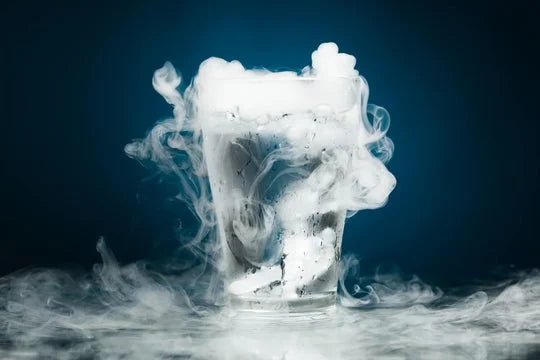Dry Ice vs. Gel Packs - Part 1: SUSTAINABILITY
Welcome to a four-part series of posts where we will compare the advantages and disadvantages of Dry Ice and Gel Packs for use in cold shipping applications. The objective is not to crown an undisputed champion of coolant but to help us better understand which tool is best for your given application.
We’ll divide up our investigation as follows:
Before we discuss sustainability, some cursory definitions:
Dry Ice is solid Carbon Dioxide (CO2) or frozen CO2. We mostly know CO2 to be a gas but at very low temperatures (below -78°C / -109°F) it behaves as a solid. At temperatures above -78°C Dry Ice will convert directly to CO2 gas, skipping the liquid phase, in a process called sublimation. This sublimation process absorbs heat from its environment making Dry Ice it a good coolant material.
Gel Packs are typically water-based refrigerants that contain gelling components to increase the viscosity of the liquid refrigerant. Gel Packs take on the thermal properties of water, freezing and melting around 0°C/32°F. The gel characteristic aids in processing and can promote uniformity in melt rates, and, depending on viscosity, prevent leakage. The gel material used will vary based on the gel pack manufacturer. Some use eco-friendly biodegradable hydrocolloids and some using non-biodegradable chemical components like sodium polyacrylate. The gel is often contained in a plastic film, often consisting of LLPDE or other flexible plastics. The gel pack is frozen and the thawing action absorbs heat from the environment, making it a good coolant material.
Dry Ice vs. Gel Packs: Sustainability
There are two major aspects of sustainability to consider when comparing Dry Ice to Gel Packs. The first is the product and material waste and the second is the carbon intensity of the production processes.
Product and Material Waste:
Gel Packs are typically encapsulated in 3 to 4 mil plastic, usually LLDPE, which is difficult to recycle and typically adds to landfill. Dry Ice is often also encapsulated in a vented plastic bag (HDPE or LLDPE) when it goes into direct-to-consumer shipments but the gauge of the plastic is typically lower than that of gel packs, meaning less material and less waste.
Gel Packs use water that can be reclaimed by the eco-system or that goes into landfill depending on the materials used. Minus Works uses readily biodegradable, plant-based components to enable the fresh water used in its gel packs to work its way back to the eco-system. Some gel pack manufacturers use Sodium Polyacrylate[1] which binds to water molecules and can bring them all the way to landfill. Minus Works also uses pre-recycled LLDPE in its gel pack containment film, thereby lowering the demand for virgin single use plastic.
Besides the vented plastic bag, dry ice does not leave behind any material that needs to be recycled or disposed of. However, sublimating dry ice is of course releasing CO2 into the atmosphere. One could make the argument that this carbon would have been released into the atmosphere anyway but that depends on whether the Dry Ice was produced as a by-product or if CO2 was purposely generated for the Dry Ice. This is a key point and discussed in more detail below.
Production Process:
The first step in the Dry Ice production process is to obtain raw material: CO2 gas. Many Dry Ice manufacturers will acquire this CO2 as a by-product of other processes like petroleum refining or the Ammonia production (for Agriculture or Defense). In the Ammonia example, natural gas is burned to separate carbon and hydrogen atoms, hydrogen is then combined with nitrogen to produce ammonia. The leftover carbon is then combined with oxygen to produce CO2.
Unfortunately there are some Dry Ice processes that do not start with CO2 being acquired as a by-product but rather fossil fuels being burned for the purpose of generating CO2 for Dry Ice. These purpose-built CO2 generators allow the dry ice plant to produce CO2 gas from the direct combustion of fossil fuels such as diesel, kerosene, or natural gas. This is a key point in the sustainability calculus of Dry Ice and shows that all Dry Ice is not created equal from an environmental stand point.
The rest of the Dry Ice production process involves cooling and high pressurization and is energy intensive. Typical processes have a yield of 33% of end product dry ice to weight of starting CO2. If the producer does not have an adequate capture mechanism to reuse that unconverted CO2 gas, that wasted carbon is bled into the atmosphere and contributes to carbon emission. So, given the yield, one lb. of dry ice can generate 3 lbs. of CO2 emissions.
The gel pack manufacturing process is a two-part process. The mixing phase is where water and additives come together to create the viscous gel. Typically the additives make up no more than 2% of the total gel by weight. The second part is a filling operating where the gel liquid is encapsulated in containment film and sealed, creating the gel pack. The gel pack manufacturing process is not energy intensive however the gel packs then need to be frozen. Generally modern commercial freezers are very efficient but by its nature, freezing water is an energy intensive exercise.
Summary
Using gel packs generates more single use plastic waste, however, using Dry Ice can generate a significantly greater carbon footprint, especially if the CO2 feedstock for the Dry Ice is not a by-product but purposely generated for the Dry Ice manufacture.
[1] Sodium Polyacrylate is the super absorbent material used in diapers which is contributing to a major landfill issue.

